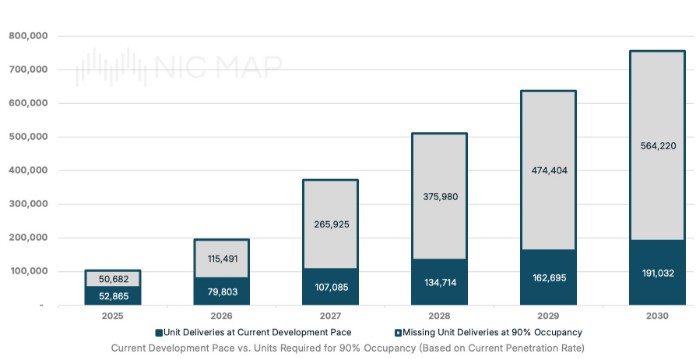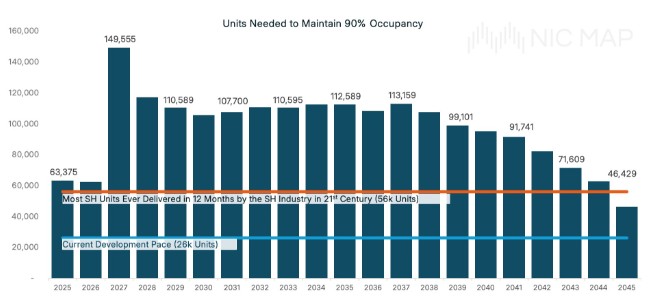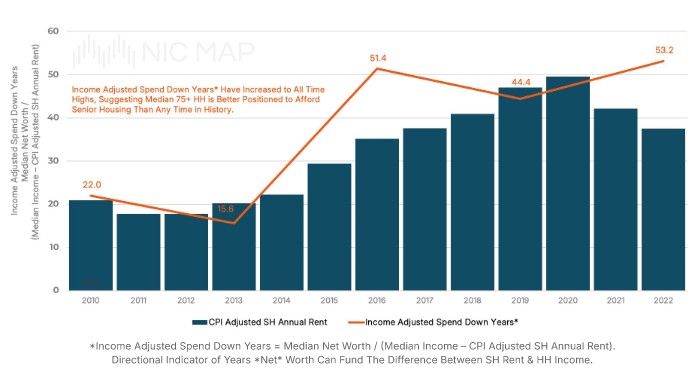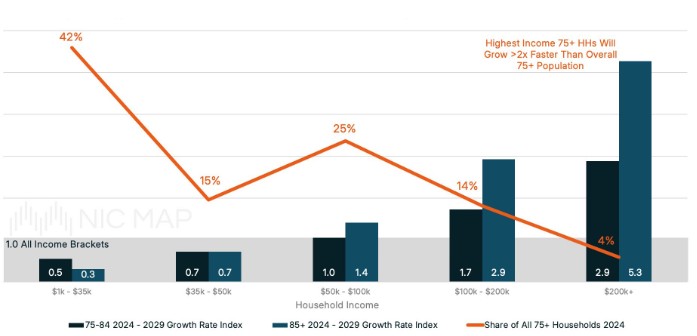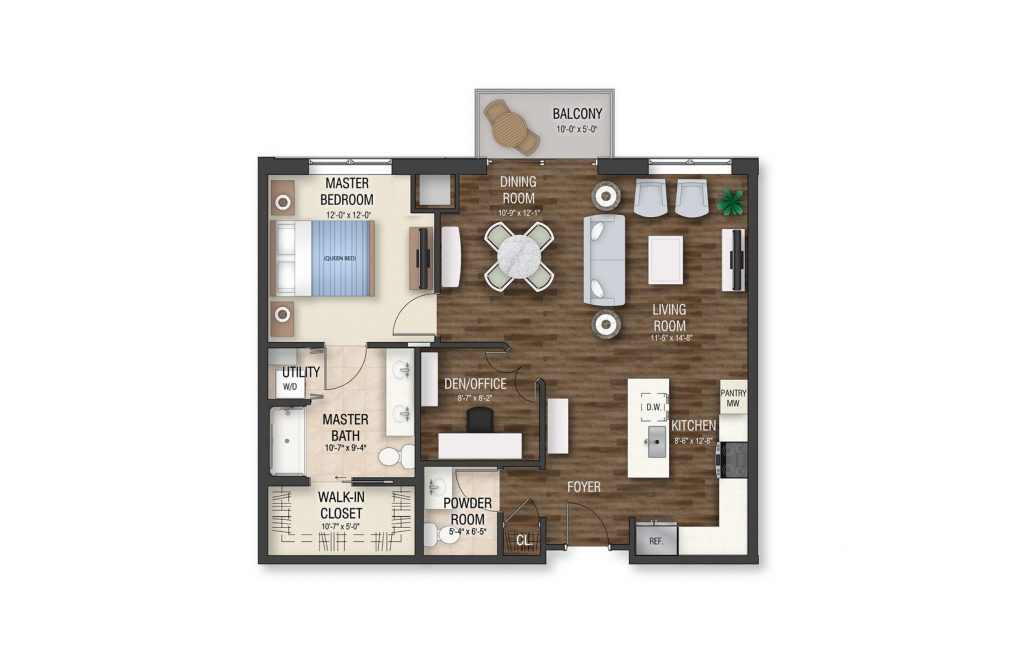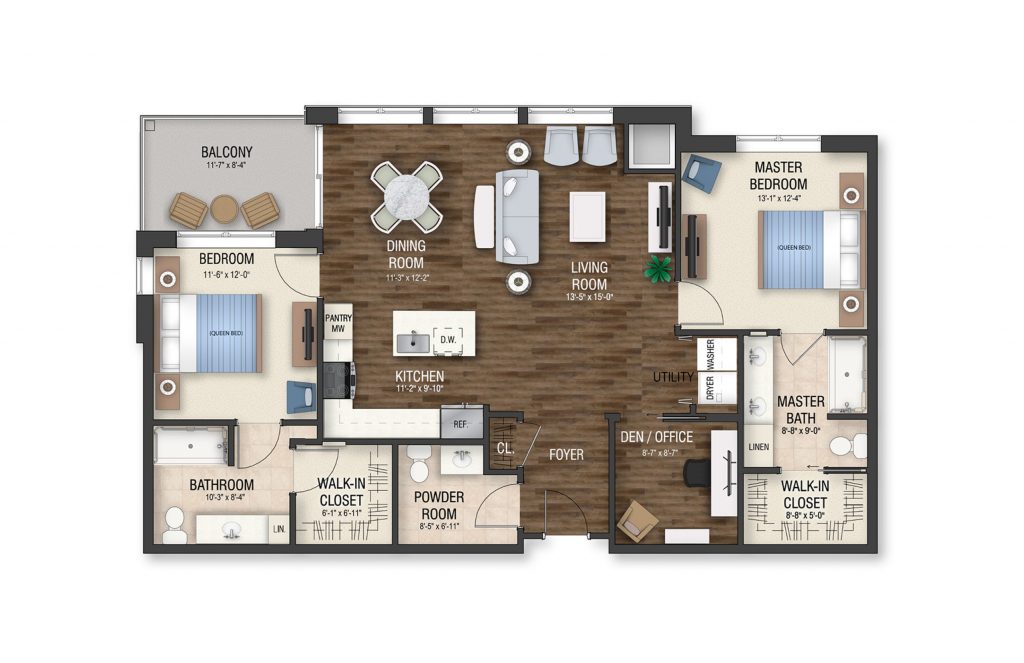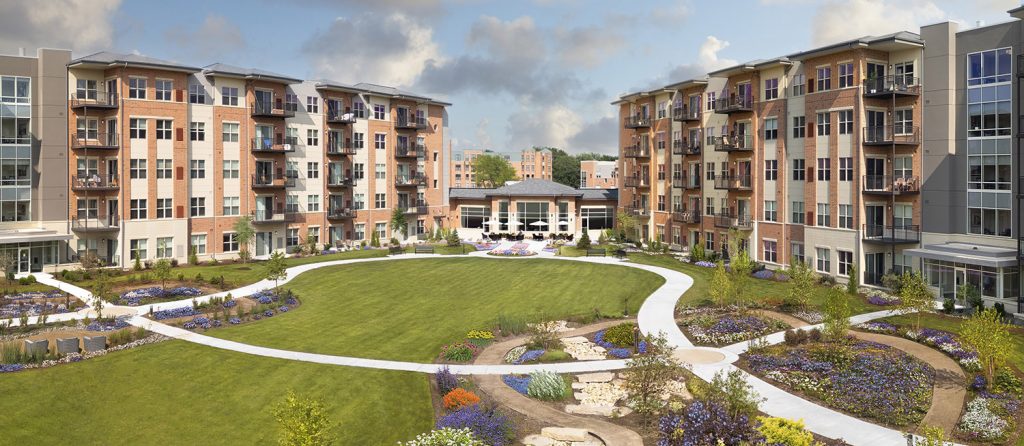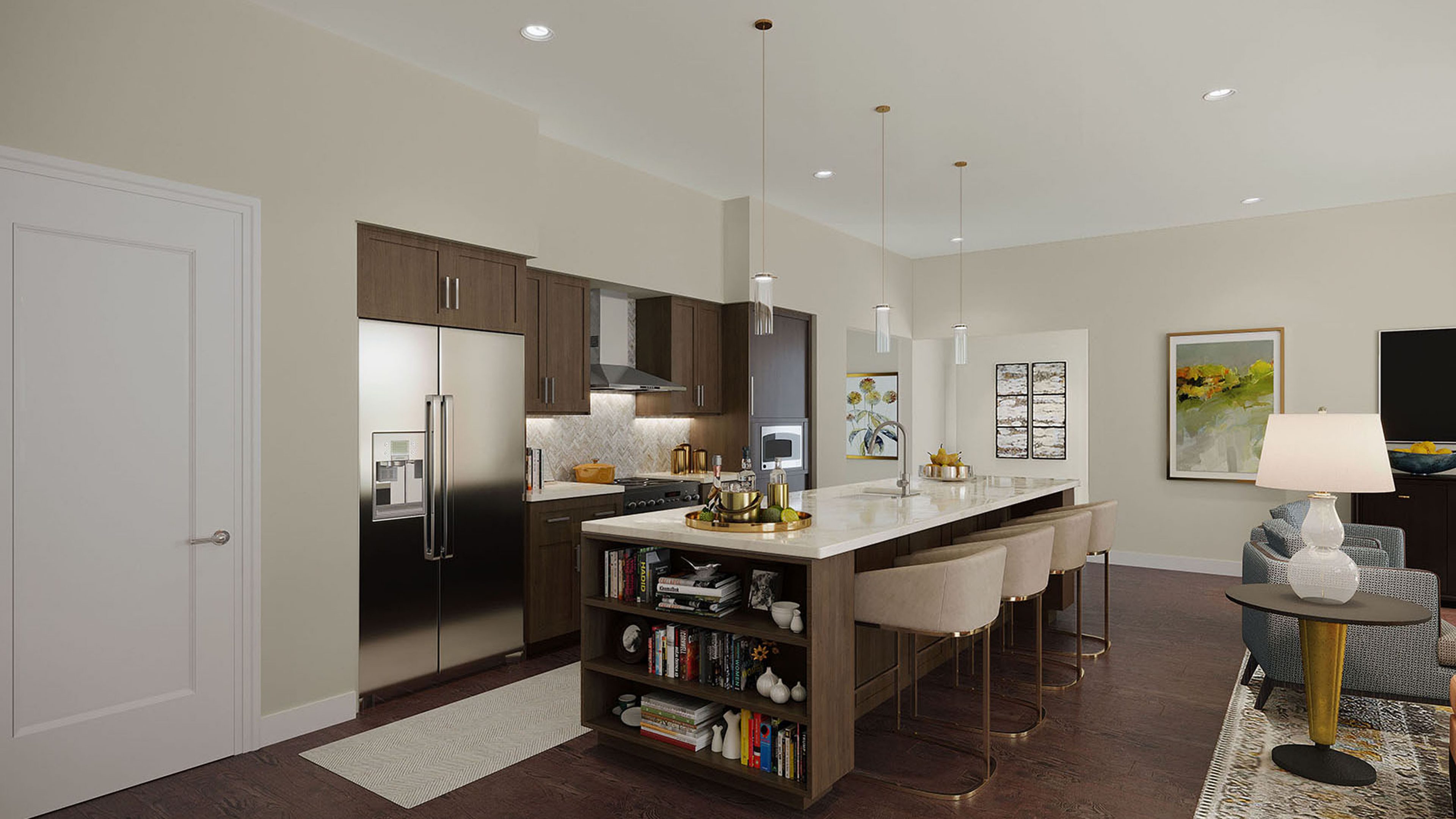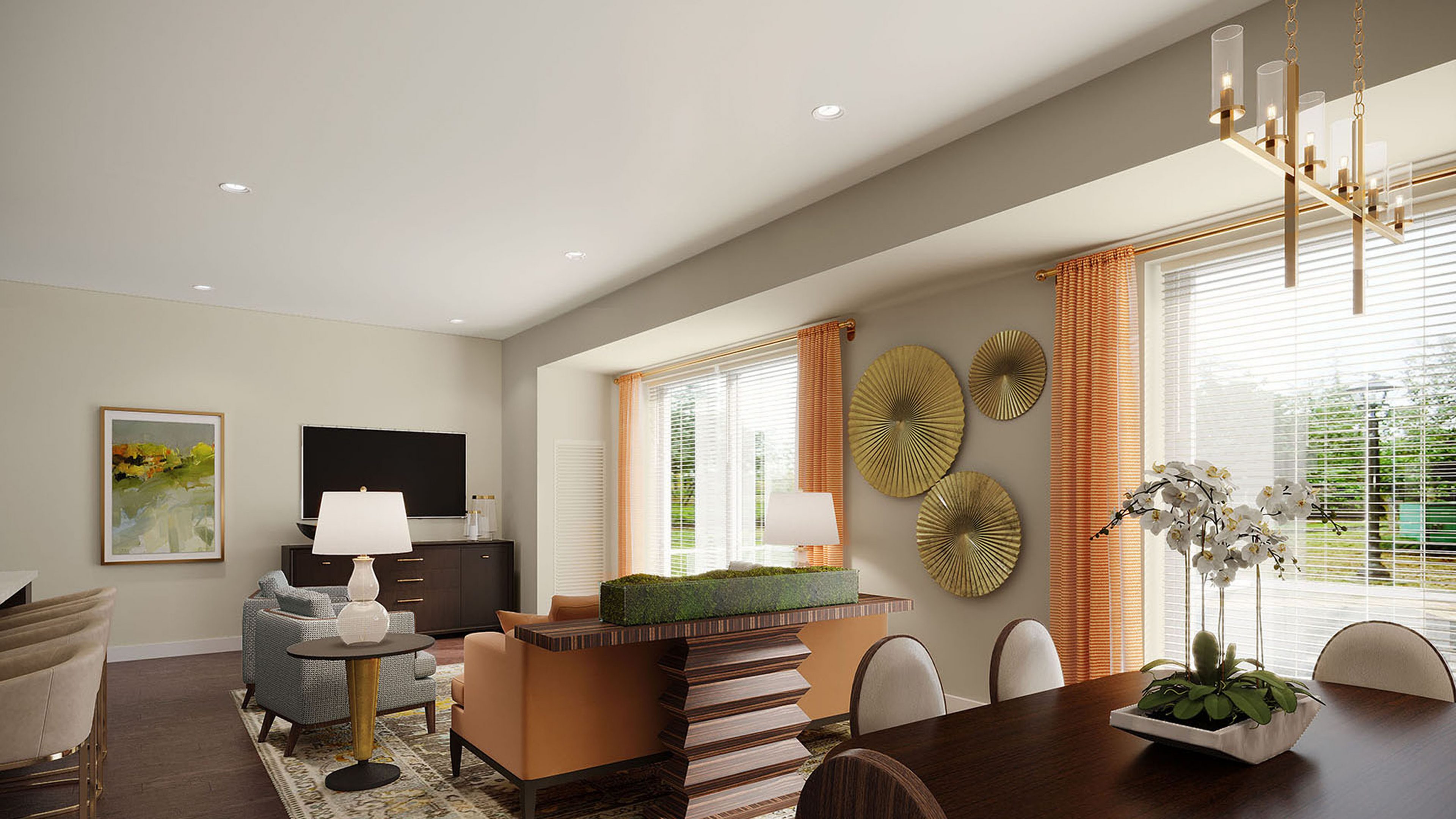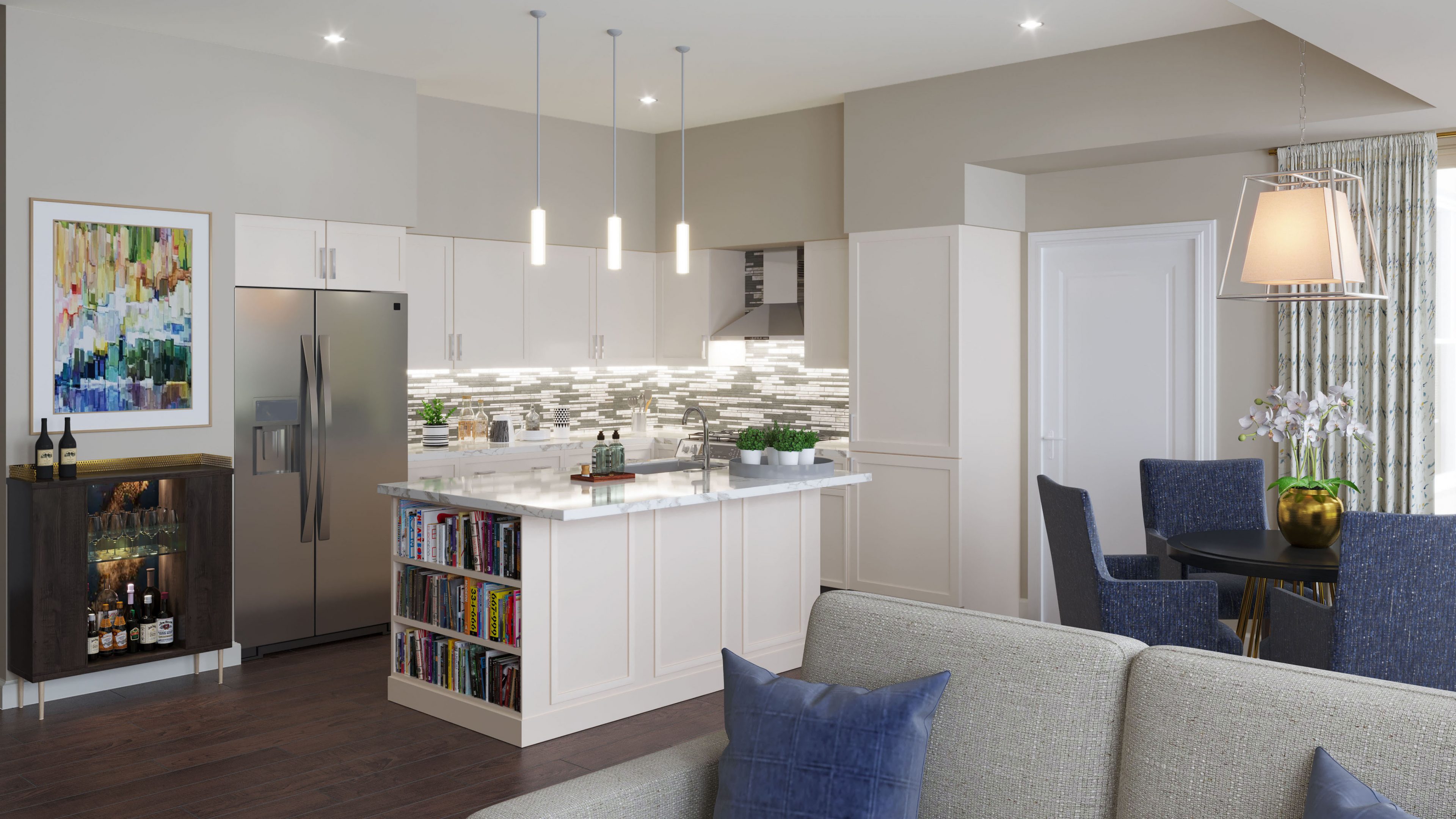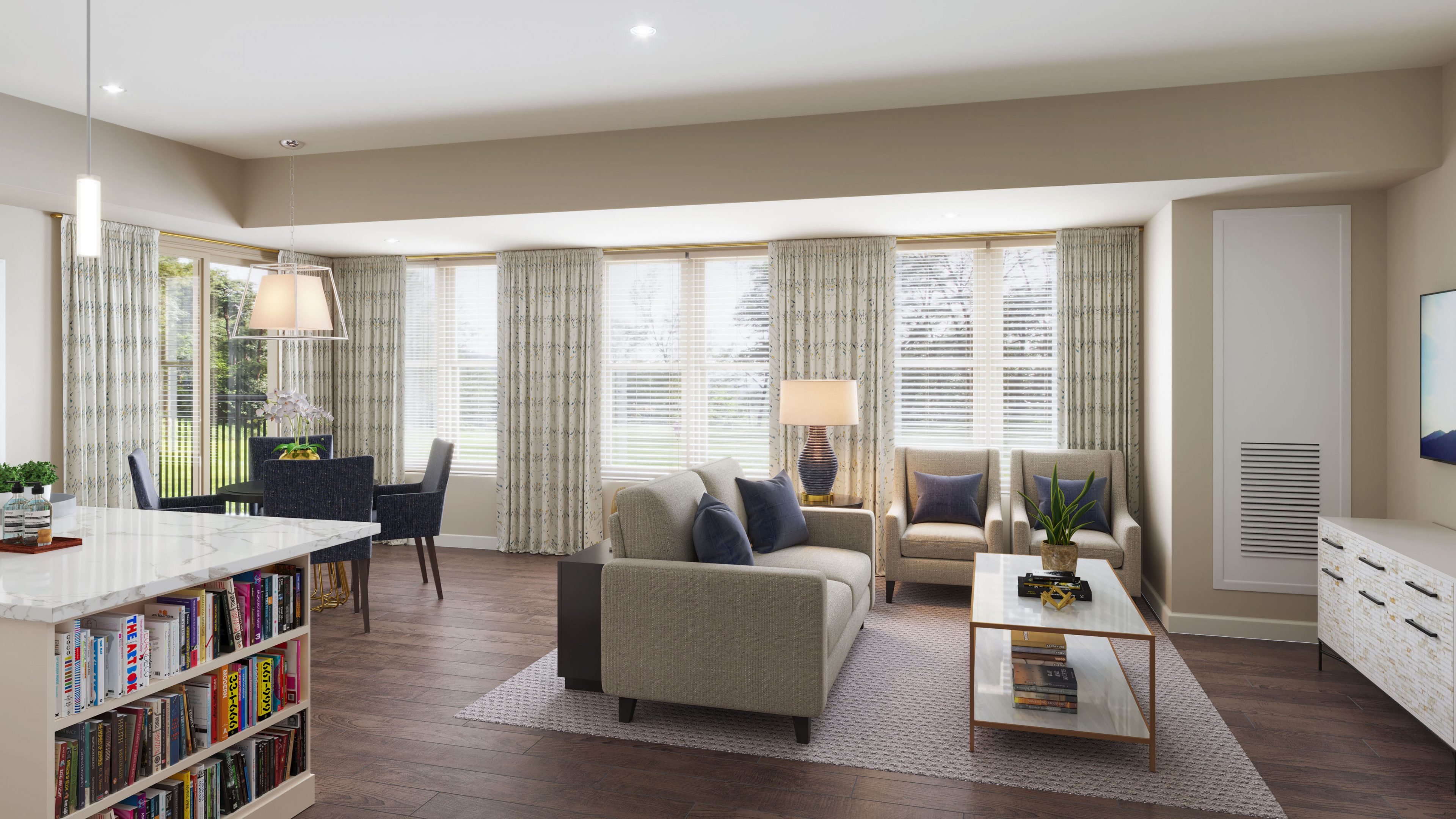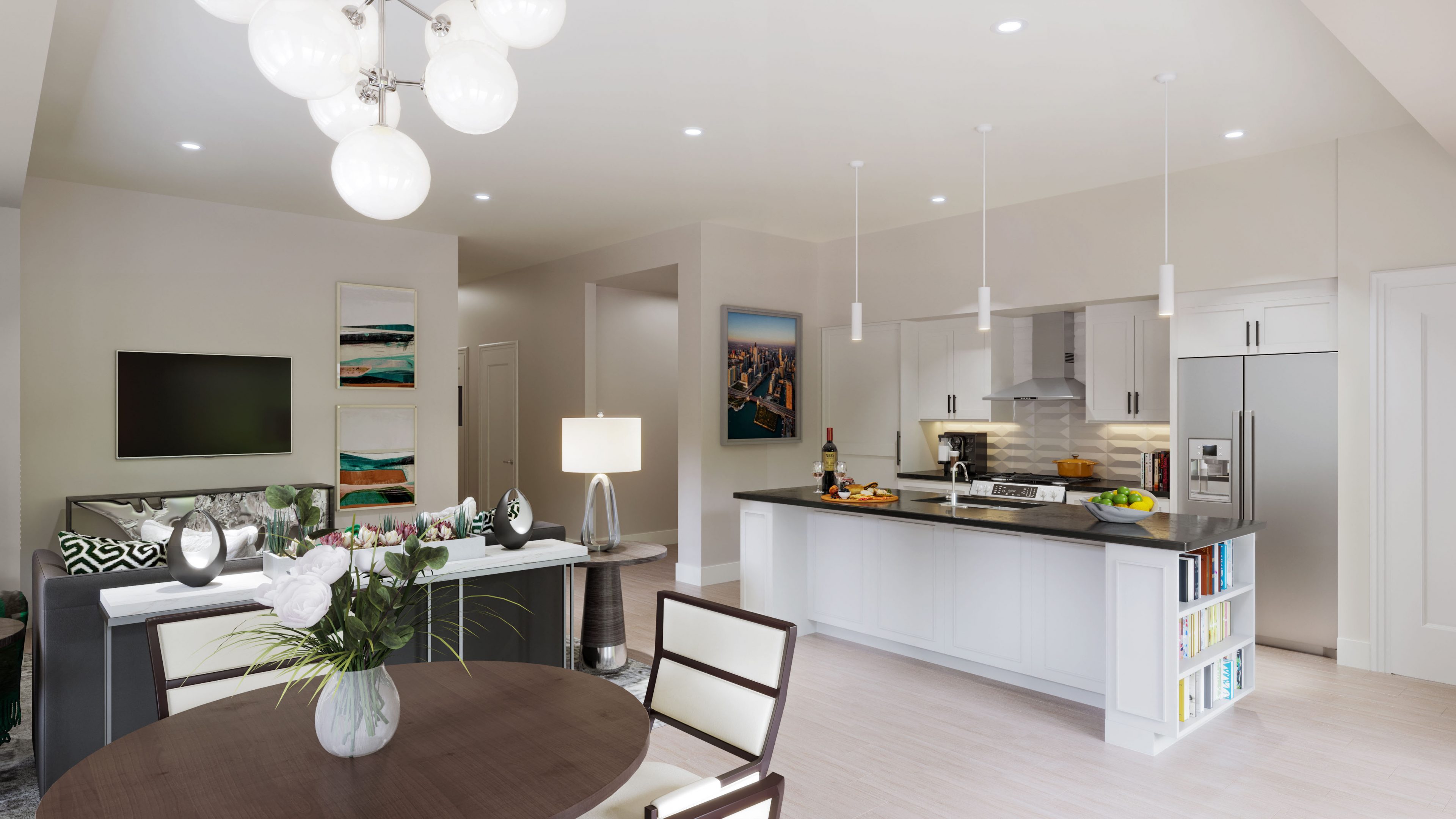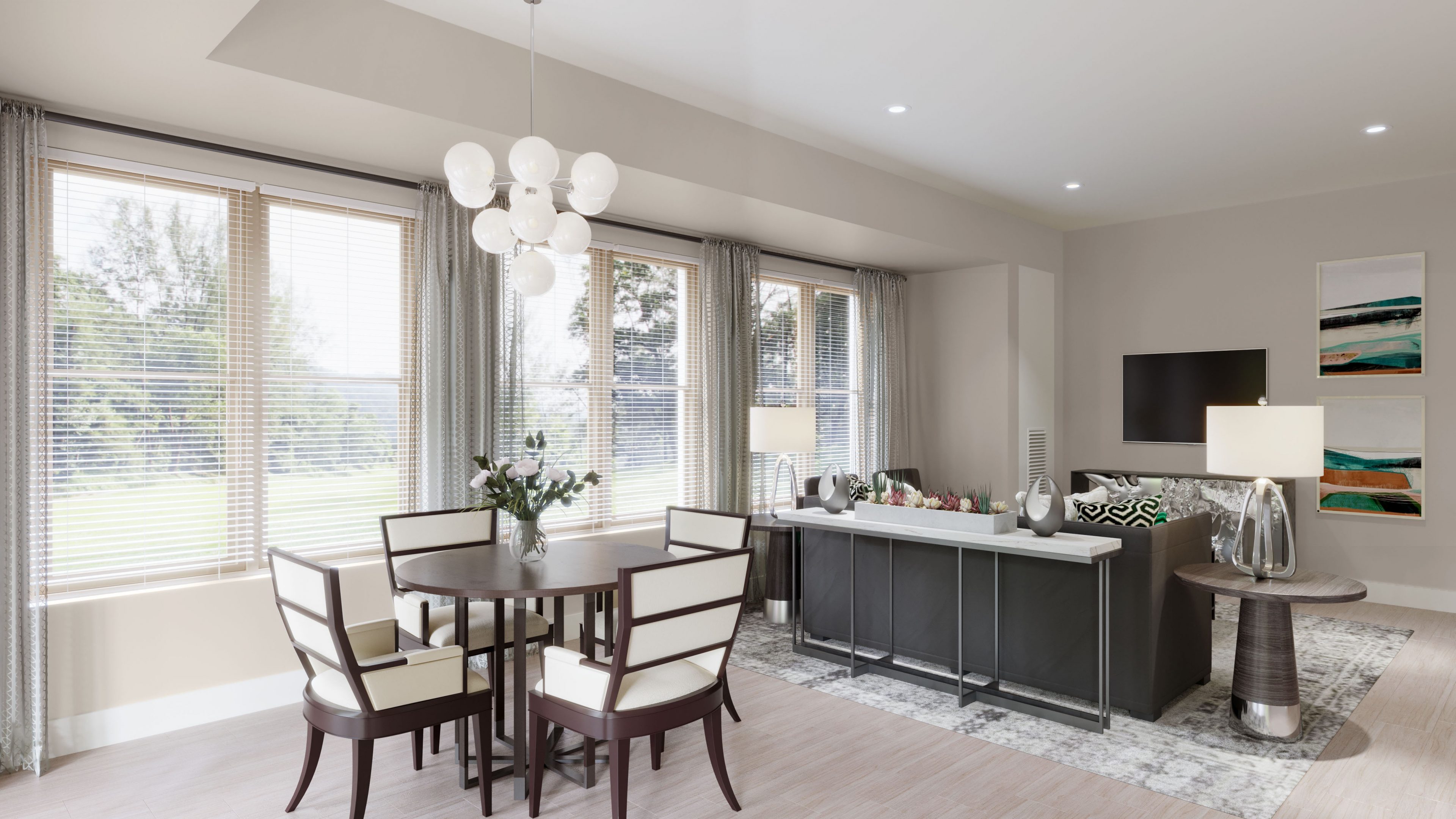Not Your Parents’ Retirement: Rethinking Apartment Design for Baby Boomers (Part 1)
Strategic design insights to attract and retain the next wave of residents with personalization, lifestyle amenities, and flexible unit plans.
The senior living industry has evolved dramatically – from institutional settings, focused on providing end-of-life care to vibrant, sophisticated environments prioritizing mental, spiritual and physical health of the individual. This shift moves away from a mindset of loss due to aging toward one of a celebration of life – offering a new vision of an active lifestyle, personalized experiences, greater flexibility and independence. The industry’s focus has shifted from just “Senior” to “Living”, offering an environment which allows people to thrive, aligning with the expectations of a generation redefining what aging looks like. This evolution is fueled by the unprecedented demand driven by the Baby Boomer population, which is threatening to exceed the growth of the housing inventory (1. Senior Housing Market Outlook – 2025 NIC Map).
This article explores how Baby Boomer expectations are shaping apartment design, decision-making factors behind the move, and the role of personalization and technology in the design of Independent Living communities. The process of personalization assists in creating a more engaging and successful sales process which appeals to this generation who values individual experiences. Finally, we will examine a case study which successfully implemented some of the design features and personalizations which appeal to this generation.
Understanding the Baby Boomer Mindset
Born between 1946 and 1964, Baby Boomers are defined by an era of prosperity and social change. They value individuality, health, community engagement, the ability to age in place and seek a more active lifestyle (2. Montgomery – Senior Housing News). These values are now shaping the next generation of senior living communities. For developers and operators, aligning with these expectations is not only a strategic advantage – it’s essential to remain relevant to meet the demand of this rapidly evolving market.

Reimagining the Transition to Senior Living
Design and development teams must understand the deeply emotional decision to move into a senior living community. Residents are often contending with the thought of leaving their long-time home filled with the most precious memories of their lives, into an apartment setting that may be perceived as age-restrictive or institutional, rather than vibrant and engaging. Imagine grappling through the thought of their first Christmas away from home or their first Fourth of July, surrounded by strangers and removed from the treasured traditions of their past.
There are many reasons for making this decision; including the loss of a significant other, declines in either physical or mental acuity, or pressure from family to be in a setting better suited for their care. It is important to understand that behind this decision may be fears related to the unknown, giving up their old life, loss of independence, making new friends, cost predictability, and the role of grief in the decision-making process. These concerns must be addressed with active and engaging environments that foster new experiences, provide emotional support and deliver tangible improvements to their lifestyle and well-being.

Apartment Design for Modern Seniors
Baby Boomers are not looking to downsize in the traditional sense, rather, they are looking for communities which reflect their lifestyle. Market trends show a shift away from smaller studio and 1-bed apartments in favor of larger apartments with dens, which can be used for guest rooms or offices. This may be due in part to the increase of financial resources that the Baby Boomers possess from previous generations and their ability to afford larger apartments (1 – Senior Housing Market Outlook – 2025 NIC Map).
Leveraging SAS’s senior living experience, we have completed master planning services for our clients who desire to eliminate these smaller apartments, which are hard to sell and often remain unoccupied, in favor of larger, open plan units with these flexible spaces. This preference for spacious accommodations by Baby Boomers will impact the assumptions about apartment mix for new developments, in particular for the middle markets and above. Architects should be forward thinking to position smaller apartments adjacent to one another in a way which makes combinations feasible with minimal structural or infrastructure impacts.
Oak Trace – Apartment Floor Plans
In addition to the desire for larger apartments, SAS Architects has seen the following apartments features become more prominent in our recent projects:
- Open-concept kitchens with generous islands for entertaining and prep
- Expansive windows that maximize natural light and fresh air
- Soaring ceiling that create a sense of openness and volume
- Private balconies designed for easy access and outdoor relaxation
- Ample storage solutions with flexible layouts to suit individual needs
As Baby Boomers are more health conscious (3. Kahana) and in a post-Covid world, SAS has seen more of an emphasis on advanced HVAC systems to provide access to fresh air, air purification technology, humidity control, filter options, and incorporation of “clean air” technology like ozone-less air ionizers.
Technology as an Expectation, Not a Perk
Baby Boomers are the first tech savvy generation entering Senior Living communities (4. Wilson). When moving into these communities, their basic expectation will be an integration of technologies they currently utilize in their home, including:
- Smart home features including thermostats, lighting and appliances
- High-speed Wi-Fi with consistent, reliable access
- Seamless streaming via built-in support for major platforms
- Voice assistants like Alexa or Google Assist fully integrated
- Smart TV compatibility with Apple TV, Roku and Fire Stick
- App-based services for dining, scheduling and social engagement
There is also an expectation that these communities provide enhanced access to technology which can be used to improve their safety and sense of well-being. These types of technologies include:
- Wearables for health monitoring and medical alert purposes.
- Smart watch connectivity to fitness equipment to measure balance, cognitive functionality, gait patterns and muscle composition. This tech helps to be pro-active in their care by detecting cognitive, cardiovascular or physical declines to mitigate future injuries.
- Fall-prevention technology
- Access control systems to connect to community access doors, apartment doors and internal payment systems to increase safety and convenience
Communities must plan for robust infrastructure to support these technological integrations, not just for the Baby Boomers’ needs, but for continued evolution into the GenX market.
Apartment Personalization Framework
With greater financial resources and design awareness, Baby Boomers expect the ability to have choice in design when selecting their next homes. A history of past home renovations, the impact of home improvement shows and the internet has equipped this generation with an expectation and awareness for design. Accommodating the desire to personalize one’s apartment is in direct conflict with the complexities of the current construction market, which is experiencing record high construction prices and high labor costs (5. Faron). In order to accommodate this desire, personalization options should be carefully curated and an organizational framework must be established to maintain clear lines of communication and accountability between the resident, sales team, design and construction teams to mitigate risk to the construction schedule, cost and quality of the project.
Personalizations are categorized into tiers based upon the level of complexity of the change and the cost implications to the project. The available options need to be carefully curated to control the complexity and presented in an understandable format that clearly outlines their options. The tiers of personalizations can be organized in the following manner:
- Standard finish packages – Include a curated finish package with three to four color palettes, along with typical appliances, lighting and plumbing fixtures at no additional cost to the resident.
- Standard upgrade packages – Include a predefined set of one-off alternates and upgraded finish material packages provided at an additional cost to the resident. These upgrades include additional options for appliances, light and plumbing fixtures and one-off upgrades like additional outlets, glass shower doors and grab bars. The upgraded finish material packages are preselected packages corresponding to the color palettes in the standard finish packages to provide higher grades of finishes and additional color options.
- Customizations – Include resident requested changes which require approval from ownership and drawings for design professionals. These changes offer the highest risk of complication for the construction process, so they must be carefully monitored and come at a higher cost due to the requirement for additional design work. Examples of these types of changes could be minor wall adjustments, door configurations, or kitchen cabinet layout adjustments which could require additional electrical outlets or plumbing lines in conflict with surrounding infrastructure.
Resident Finish and Fixture Packages
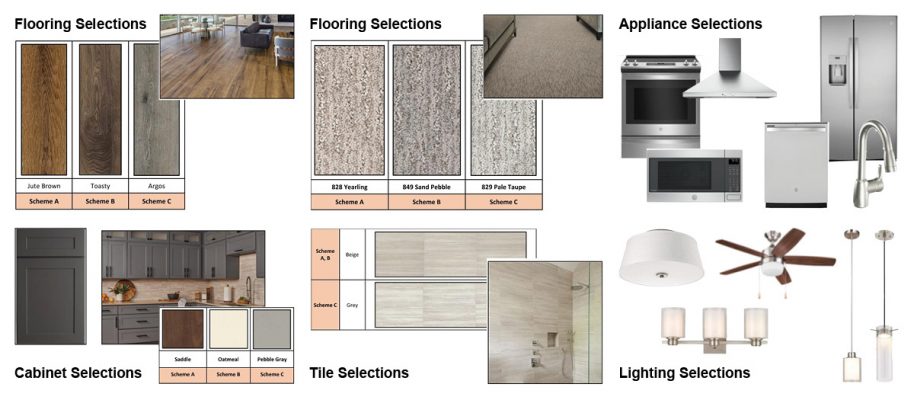
To implement a personalization process effectively, it is critical, early in the project, to establish the guidelines on what will be included in each tier of personalizations along with those options which will not be allowed through the customization process – i.e. structural changes, exterior alterations or infrastructure changes. It is critical to establish the team who will be responsible for the personalizations process and define the roles of each team member.
- Owner / Developer – Primary decision makers to approve finish palettes, assemble team and decide guidelines on acceptable levels of customization.
- Sales / Marketing Team – Primary conduit for communication with the resident, meet sales goals, coordinate selections meetings to maintain schedule, tracking financials and communicate to design/construction teams.
- Architect – Educate the sales teams, assemble packages, issue design sketches, review code compliance of changes, assist in resident communications and coordinate with the Contractor.
- Interior Designer – Assemble interior finish packages.
- Contractor – Obtaining and managing pricing for all options, confirming feasibility of customizations, communication with subs, implementation in the field, and maintaining construction schedule. This process is time intensive and the Contractor should dedicate proper personnel to implement the requested changes.
Typical Personalization and Communication Process
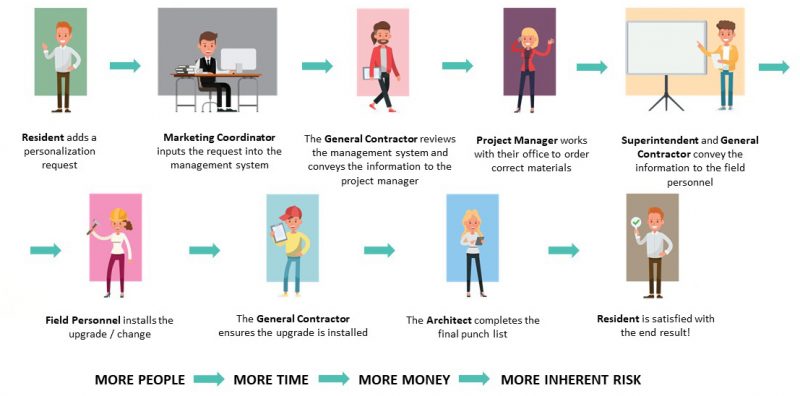
Given the number of people involved in this process and the number of options available, it is essential to utilize a management system to organize the selections for each apartment, track costs, manage schedules and assist with implementation and verification in the field. This system, along with clear communication, ensures a smooth process while minimizing construction risks. Although risky and time intensive, the personalization process can be fun and engaging and increase depositor engagement, thus ensuring they convert into residents.
Case Study: Oak Trace
Oak Trace’s success highlights the power of aligning design, marketing and resident engagement. Originally conceived in 2018, the project was reimagined due to the emergence of Covid and the resulting slow down in sales. This allowed Lifespace Communities the opportunity to reimagine the project to include additional amenities, both interior and exterior, and updated apartment designs. Despite the redesign, the marketing team was able to maintain the majority of their presales from the previous design, while obtaining the required sales to kick off construction.
The sales team succeeded by addressing the emotional complexities of transitioning into a Senior Living Community and transforming it into a positive, engaging experience. Prospective and current depositors were invited to participate in multiple design presentations, where they provided input on amenity spaces, voted on design styles and color palettes, and tracked project progress. Educational seminars helped residents understand the financial aspects of the move, effective downsizing strategies, and included Q&A sessions with the design and construction teams. Throughout construction, residents were engaged in the personalization process — choosing finishes, fixtures, and in some cases, layouts — giving them a sense of ownership and control over their future homes.
The momentum continued with monthly updates, including photos and videos, and regular social events to foster connections. Building-wide and floor-specific gatherings helped residents build community and form friendships before move-in. Communication was a consistent priority. Each event was followed by personalized calls and one-on-one meetings, keeping residents informed and invested. By move-in, many had already built strong social ties, shaped their apartments to their liking, and felt ready to fully embrace their new life at Oak Trace.
Project Highlights
- Completed: January 2024
- Project Stats: 325,000 SF | 140 Apartments
- Average Apartment Size: 1,280 SF
- Apartment Features: Open Plan Layout, Large Windows, High Ceilings, Exterior Balconies
- Community Amenities: Restaurant-Style Dining, Formal Dining, Bar Lounge, Café / Bistro, Market, Outdoor Dining, Fitness Spaces, Salon & Spa, Pool / Whirlpool, Performing Arts Center, Game Room, Exterior Gardens and Accessible Walking Paths
Personalization Statistics
- Management System: BlueFingerprint
- Total Standard / Upgrade Selections: 4,269
- Total Customizations: 218
- Total Cost for Personalizations: $376,028.15
- Average Upgrades per Apartment: 32
- Average Personalization Cost per Apartment: $2,685.92
Oak Trace – Personalization Selection Statistics
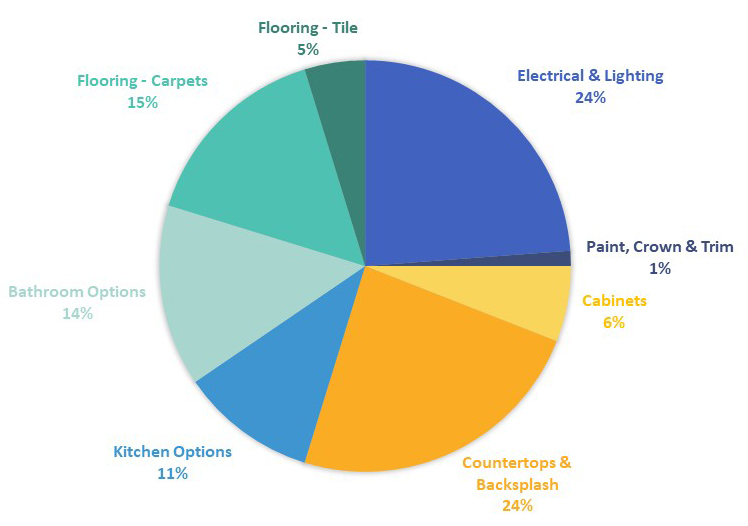
Summary
As the industry enters a new era shaped by discerning, tech-savvy residents, operators and developers must adopt design strategies that reflect evolving values. At SAS Architects & Planners, we partner with communities to bring these visions to life — combining design intelligence, personalization systems, and strategic planning to deliver spaces where future residents can thrive.
Ready to take the next step? Reach out to SAS to start a conversation about designing communities where residents don’t just age — they thrive!
Referenced Sources:
- “Senior Housing Market Outlook: Opportunities from a Supply and Demand Imbalance.” NIC Map, 2025.
- Montgomery, Austin. “5 CEOs Respond to “Disruptive Mindshift” of Senior Living Consumers.” Senior Housing News, 24 Mar. 2025, seniorhousingnews.com/2025/03/24/5-ceos-respond-to-disruptive-mindshift-of-senior-living-consumers/. Accessed 14 Apr. 2025.
- Kahana, Eva, and Boaz Kahana. “Baby Boomers’ Expectations of Health and Medicine.” Virtual Mentor, vol. 16, no. 5, 1 May 2014, pp. 380–384, https://doi.org/10.1001/virtualmentor.2014.16.05.msoc2-1405.
- Wilson, Anthony. “Adapting to Changing Consumer Preferences: A Boomer’s Perspective in Senior Living – National Investment Center.” National Investment Center, 6 June 2024, www.nic.org/blog/adapting-to-changing-consumer-preferences-a-boomers-perspective-in-senior-living/?_gl=1. Accessed 14 Apr. 2025.
- Faron, Doug. “How Rising Construction Costs Are Impacting Real Estate Development.” Blog.naiop.org, 5 Dec. 2023, blog.naiop.org/2023/12/how-rising-construction-costs-are-impacting-real-estate-development/.


